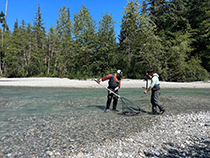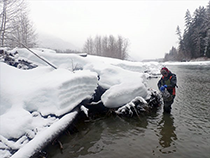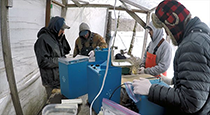Commercial Salmon Fisheries
Southeast Alaska & Yakutat Research: Unuk River Chinook Salmon Research

Figure 1. — Click for more Info

Figure 2. — Click for more Info

Figure 3. — Click for more Info

Figure 4. — Click for more Info

Figure 5. — Click for more Info

Figure 6. — Click for more Info

Figure 7. — Click for more Info

Figure 8. — Click for more Info

Figure 9. — Click for more Info

Figure 10. — Click for more Info

Figure 11. — Click for more Info
Overview
The Unuk River is a glacial system located approximately 85 km northeast of Ketchikan, Alaska (Figure 1.). Over the past few decades this river has supported runs of Chinook salmon averaging about 5,000 large Chinook salmon (essentially 28" and greater in length). After leaving the freshwater as juveniles, these fish primarily rear in or near Southeast Alaska and this stock is caught primarily in marine sport and commercial fisheries in northern and southern Southeast Alaska. Data from this project are used to estimate full brood year production estimates including details on harvest, exploitation rate, marine survival, and smolt abundance.
Standardized observer counts using aerial and foot surveys of large Chinook salmon spawning abundance have been performed by the Alaska Department of Fish and Game (ADF&G) annually since 1977. Since these counts only represent a fraction of the overall total spawning abundance, mark-recapture studies were performed from 1997 to 2009 and in 2011 (Hendrick et al. 2008) to develop a factor to expand peak counts to estimates of large spawning fish. Due to a change in the river channel, mark-recapture studies ended after 2011 and expanded peak counts have been used since. In 2021 and 2023, transgenerational genetic mark-recapture (tGMR) projects were conducted which will be used to further refine the expansion factor.
An escapement goal of 650 to 1,400 large fish was developed for this stock in 1997 (McPherson and Carlile 1997) based off observer counts. After several years of mark-recapture studies, this goal was updated and revised to 1,800 to 3,800 large spawning Chinook salmon in 2008 (Hendrich et al. 2008). This goal range was reviewed and adopted by ADF&G and the Chinook Technical Committee of the Pacific Salmon Commission in 2009.
Available information on this stock since 2007 suggests that about 37% of the fish are harvested annually in marine sport and commercial fisheries. This stock, like others in Alaska, has recently experienced a decline in productivity. From 1977 to 2011, the Unuk River met or exceeded the lower bound of the escapement goal every year (34 straight years; Figure 2). However, between 2012 and 2017, the Unuk River missed the lower bound of the escapement goal in 5 years which led to its designation as a stock of concern in 2018. Since this designation, management restrictions have increased, and the Unuk River harvest rate has dropped to an average of 29%. As a result, the lower bound of the escapement goal has been met in 5 of 7 years from 2018 to 2024. Unuk River salmon research provides fishery managers the tools necessary to manage under the sustained yield principle, representing a prime example where detailed stock assessment information, coupled with responsive management, can achieve base level escapements even in the face of poor production.
Adult Spawning Abundance
Since 1977, total escapement, based on mark-recapture studies or expanded peak observer counts in years lacking mark-recapture, has ranged between 956 and 10,541 large fish, with an average of 4,301 large fish. In the mark-recapture studies, Chinook salmon are captured in the lower Unuk River (Figure 3) in June and July and marked and tagged as part of event 1 of the mark-recapture study. Fish are also sampled for age, sex, and length (ASL) information. Then in late July and August, in six principal spawning areas, fish are sampled for marks and tags as part of event 2 of the mark-recapture study and sampled for ASL information (Figures 4 and 5). All fish are also checked for the presence of adipose fins and fish missing adipose fins are additionally sampled for the presence of a coded wire tag (CWT) which would have been applied to fish during their juvenile life stage (Figures 6 and 7). All sampled fish are then given a distinct mark to avoid resampling of any recaptured fish and subsequently released. Fish are sampled on the spawning grounds using rod and reel snagging gear, dip nets, or sampled as carcasses.
At this time, mark-recapture studies are not occurring on the Unuk River. However, to counter the loss of the lower river sampling program (event 1 of the mark-recapture study), spawning grounds age, sex, length, and CWT sampling efforts have been bolstered such that 23% of the total large Chinook salmon escapement has been physically sampled since 2018. These very high sampling rates are a tremendous feat leading to improved precision in various resulting analyses.
Project operational plans are published annually to outline project methods, results, and data analyses, and are available on-line. Information gathered from this work is published in the ADF&G Fishery Data Series and is complete through parent years 2005 (PDF 4,924 kB), and 2006 (PDF 2,814 kB).
Juvenile Abundance
The ADF&G salmon research group has conducted studies to estimate the abundance of juvenile Chinook salmon in the Unuk River drainage since 1994. Juveniles from the same parent year are marked with adipose fin clips and tagged with CWTs as fingerlings (or "parr") during the fall (September and October), and again the following spring as smolt before they emigrate to sea in April and May. Tagging in the fall and spring greatly increases the total number of fish leaving the Unuk River possessing a CWT. On average, 27,500 parr and 9,500 smolt have been tagged each year and smolt abundance has ranged from 88,000 to 767,000 since 1994 (Figure 8).
Juveniles are captured primarily using minnow traps baited with disinfected salmon eggs and trapping occurs exclusively in the mainstem and side sloughs of the lower river (Figure 9). After fish are captured, they are transported back to camp and anesthetized, marked, coded-wire-tagged, and held for 24 hours to assess retention of CWTs and ensure they are healthy prior to release back into the appropriate habitats (Figure 10).
Unuk River Chinook salmon rear at sea from one to five years and information accumulates annually on these parent year releases as returning adults are sampled. The fraction of fish marked with adipose fin clips is used in combination with adult sampling information to estimate smolt abundance. In addition, the fraction of these fish possessing valid CWTs released in the Unuk River is used to estimate adult harvests in the various marine sport and commercial fisheries. Data collected from coded wire tag recoveries, when combined with adult spawning abundance estimates, helps researchers estimate complete parent year production, including details on marine harvest, exploitation rate, smolt abundance, and marine survival of Unuk River Chinook salmon (Figure 11).
To learn more about how the department conducts this research, project operational plans are published online annually that outline methods, past results, and data analysis, including the most recent plan which covers the 2022–2024 field season. The 2024–2026 operational plans are in press.
Selected Publications
Unuk River Adult Spawning Abundance
- Juvenile abundance and harvest of Unuk River Chinook salmon, 2022–2024 (PDF 1,953 kB)
- Estimating adult Chinook salmon abundance on the Chilkat and Unuk Rivers using transgenerational genetic mark–recapture (PDF 1,205 kB)
- Escapements of Chinook salmon in Southeast Alaska and transboundary rivers in 2022 (PDF 1,280 kB)
- Operational Plan: Production and harvest of Unuk River Chinook salmon, 2020–2022 (PDF 1,999 kB)
- Operational Plan: Production and harvest of Unuk River Chinook salmon, 2018–2020 (PDF 1,759kB)
- Escapements of Chinook salmon in Southeast Alaska and transboundary rivers in 2018.(PDF 1,239 kB)
- Production and harvest of Unuk River Chinook salmon, 2017-2018.(PDF 1,249 kB)
- A Mark-Recapture Experiment to Estimate the Escapement of Chinook Salmon in the Unuk River, 2013(PDF 1,180 kB)
- Production of Unuk River Chinook Salmon through 2008 from the 1992-2005 Broods(PDF 4,924 kB)
- Production of Unuk River Chinook Salmon through 2009 from the 1992-2006 Broods(PDF 2,814 kB)
- Optimal Production of Chinook Salmon from the Unuk River(PDF 1,983 kB)
Unuk River Juvenile Abundance
- Juvenile abundance and harvest of Unuk River Chinook salmon, 2022–2024 (PDF 1,953 kB)
- Operational Plan: Production and harvest of Unuk River Chinook salmon, 2020–2022 (PDF 1,999 kB)
- Operational Plan: Production and harvest of Unuk River Chinook salmon, 2018–2020 (PDF 1,759kB)
- Production and harvest of Unuk River Chinook salmon, 2017-2018.(PDF 1,2490 kB)
- Chinook Salmon Coded Wire Tagging on the Unuk River, Southeast Alaska: 2013-2014(PDF 444 kB)
- Production of Unuk River Chinook Salmon through 2008 from the 1992-2005 Broods(PDF 4,924 kB)
- Production of Unuk River Chinook Salmon through 2009 from the 1992-2006 Broods(PDF 2,814 kB)
Unuk River Action Plans
- Unuk and Chickamin Chinook salmon stock status and action plan, 2022 (PDF 6,814 kB)
- Unuk River King Salmon Stock Status and Action Plan, 2018 (PDF 5,365 kB)
